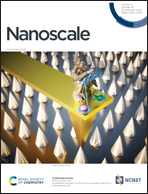Intrinsic electrocatalytic activity of a single IrOx nanoparticle towards oxygen evolution reaction†
Abstract
Identifying the intrinsic electrocatalytic activity of an individual nanoparticle is challenging as traditional ensemble measurements only provide average activity over a large number of nanoparticles and may be greatly affected by the ensemble properties, irrelevant to the nanoparticle itself. Here, single-particle collision electrochemistry is used to investigate the electrocatalytic activity of a single IrOx nanoparticle towards the oxygen evolution reaction (OER). The collision frequency is linearly proportional to the nanoparticle concentration. The mean peak current and transferred charge, extracted from current spikes of the collision, present a similar potential dependence relevant to IrOx intrinsic activity. The turnover frequency (TOF) is determined as 1.55 × 102 O2 s−1, which is orders of magnitude larger than TOFs of the reported ensemble systems. In addition, the deactivation of a single IrOx nanoparticle is also explored based on a half-width analysis of current spikes. This versatilely applicable method provides new insights into the intrinsic performance of a single nanoparticle, which is essential to reveal the structure–activity relations of nanoscale materials for the rational design of advanced catalysts.



 Please wait while we load your content...
Please wait while we load your content...